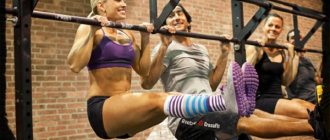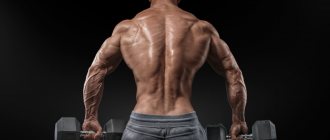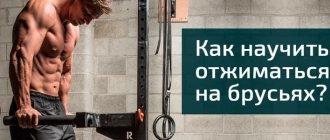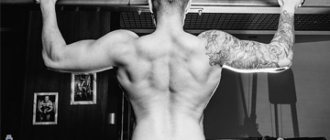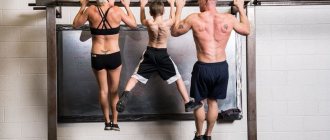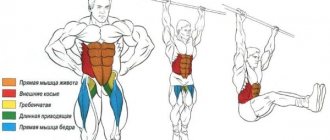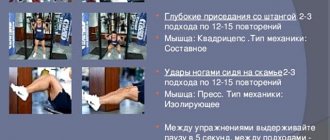The parallel bar push-up came into bodybuilding from artistic gymnastics. The exercise trains all the “pressing” muscles - chest, triceps, front deltoids. The load can be adjusted by changing the angle of inclination of the body. The more he goes forward, the more the pectoral muscles are loaded. A more vertical position of the body allows you to work the triceps first. The option with an emphasis on triceps is considered basic; training the pecs with push-ups is more common in street gymnastics, rather than in bodybuilding.
Execution technique
Acceptance of the starting position
The exercise is performed in support on the uneven bars. To accept it, you must:
- take the parallel bars with a medium grip, palms facing each other;
- by lightly jumping with your legs, take a standing position;
- move your shoulders away from your ears, relax your trapezius;
- place the body vertically so that it stands stably in the bars
The starting position can also be taken from a stand if the projectile is high and it is not possible to jump into a standing position without overloading the shoulder joints. Push-ups in the gym are performed on standard racks that have foot rests. If the exercise is done with a weight attached to the belt, it is advisable not to take the starting position on the uneven bars with a jump, so as not to injure your shoulders.
Movement
Lowering the body occurs with inhalation. You need to inhale slowly and lower your body under control in one movement, elbows bent together. Exhalation occurs with effort. Having lowered your body until your forearm is parallel to the floor, you should exhale sharply and, as it were, “squeeze” your body up. Next, the entire planned series of push-ups is performed, and the athlete places his feet on the bars and carefully returns to the starting position. During movement, you need to focus on the work of the triceps.
Attention
A technical mistake is to slouch your shoulders forward and perform the exercise with a round back. This is dangerous because when you slouch, the shoulder joints are overloaded, and the person risks injuring the ligaments.
There is no need to “insert” your elbows as on a competitive bench press, this overloads the elbow joints and when performing other high-repetition work on the elbows (presses in machines, with a barbell and with dumbbells), it can lead to injury;
“Throwing” the body down is also a mistake and can lead to injury. In addition, the lack of control during the lowering phase does not allow the athlete to effectively work out the muscles.
Raising the elbows to the sides in the triceps version of the press is not allowed, since the athlete thus shifts the load on the pectoral muscles.
Recommendations
- Preliminary joint warm-up and light stretching of the triceps, anterior shoulder and biceps are mandatory;
- Each athlete must find an adequate depth of descent for themselves, comfortable for the shoulder joint, and convenient anthropometrically. Push-ups that are too deep can cause hyperextension of the ligaments.
- You can consciously press your elbows to your sides, this will remove excess stress from the muscles of the shoulders and chest, and shift the work to the triceps.
- It is important to stop at the bottom point, contract the muscles, and avoid inertia in the movement in order to get more targeted work;
- Straightening your legs will help avoid swaying and excessive leaning forward. With your knees bent, it is easier to perform the “chest” rather than the triceps version of this exercise.
It's DIPS, baby! (for BREASTS)
Sports exercises and tips in pictures and videos
Anyone who wants to have a beautiful and inflated lower back should know how to pump up their lower back at home or on a horizontal bar.
Because without exercise you won’t be able to achieve the best results. Lower back exercises are actually easy, but require regular exercise and proper nutrition. All you need to start with is motivation, decide what results and why you want to achieve. This energy and desire will always help you when you want to quit training halfway towards your goal.
https://youtube.com/watch?v=aP8EOhmg4QM
Set goals and achieve them, but remember about health and proper diet and exercise.
Since overload also harms human health, you need to decide on the measure that you will observe, gradually increasing the load with the arrival of new strength, endurance and energy. Find out: how to pump up your lower back muscles at home.
How to pump up your lower back at home
Of course, you don't need to go to the gym to pump up your lower back, although it's much faster there. But even at home there is a whole range of exercises necessary for the lower back that will effectively and safely allow you to achieve results.
At home, it is advisable to pump your lower back every other day to give it some rest and not overload it, so as not to harm your health.
Work your lower back slowly for the first time, gradually increasing the load.
Make a plan and schedule for training every other day at the same time, following your diet and exercise routine. And also, knowing immediately what exercises you will perform and in what sequence.
How to pump up your lower back on the horizontal bar
Of course, to pump up your lower back on the horizontal bar, you can install it at home. But if this is not possible, then you can easily find or make a horizontal bar on the street.
Exercises for the lower back on the horizontal bar do not require heavy loads; they simply do not need to be done for health reasons.
First you need to develop the correct technique, and only then increase the load.
The problem is that often incorrect exercises lead to various injuries and poor health. Therefore, watch how you need to properly pump your lower back muscles and follow this example until you get used to training this way and develop a certain training technique. Find out what there are: exercises for the lower back.
Exercises on how to pump up your lower back at home or on a horizontal bar
Bend the torso forward. Take a lightly weighted barbell or a simple stick and bend your torso, keeping your back straight. Lower and rise slowly, fixing the load. Don't lift too much weight at first.
Squats with dumbbells. You can also do simple squats, but using dumbbells. Try to do squats not quickly as usual, but slowly, trying to put the load not on your legs, but on your spine.
Pull-ups on the bar. You need to pull yourself up not as usual, with your chin touching the bar, but on the contrary, pulling up the back of your neck and back. This exercise is the most effective for pumping up your lower back on the horizontal bar or at home. Find out what it is: gymnastics for the lower back.
Recommendations on how to pump up your lower back at home and on the horizontal bar
Don’t come up with complicated exercises for your lower back, especially with heavy weights. Start developing your technique.
Do small loads at first, gradually increasing them.
Remember to eat 3 times a day, exercise 2 hours after meals. Drink more water and try to eat all the healthiest foods, fish - 2 times a week, meat - every other day.
Always motivate yourself before training and set specific goals.
Very often you can see exercises on the horizontal bar in the list of exercises among athletes and bodybuilders. Thanks to the horizontal bar, you can pump up the muscles in your arms and back. The result of daily exercise will be a strong muscle corset and a beautiful figure. In addition to appearance, the direct effect on your spine is also taken into account. For example, regular exercise helps prevent possible back diseases. With low mobility, the space between the vertebrae is significantly reduced, which becomes the cause of back diseases. As a preventive measure, you need to do stretching. The horizontal bar will be especially useful for the spine if you have problems with it. But before you start exercising, there are rules that you should familiarize yourself with.
Pectoral dips
The emphasis on the pectoral muscles can be shifted if you choose a projectile with a wider handle arrangement. This will make it easier to perform the exercise with elbow extensions. However, finding such bars is not always possible if the athlete has outstanding anthropometry. In this situation, parallel push-up stands help; they can be positioned so that it is convenient to spread your elbows during push-ups.
Taking the starting position
This stage differs only in that the grip will initially be wider, but the palms will also be directed towards each other. The body remains vertical, the spine is perpendicular to the floor. The arms are bent at the elbow joints, the body is lowered clearly vertically. The legs can be bent at the knees so that the center of gravity of the body shifts, thereby giving the body the correct vertical position.
Movement
When lowering while exhaling, the elbows spread, the body smoothly lowers down, the angle between the forearms and the body is approximately 40 degrees;
The push-up occurs in a smooth, controlled manner, but insertion of the elbows should be avoided. This will protect not only the ligaments from inflammation, but also the joint itself from destruction.
Attention
Lowering the body down must be controlled. “Throwing” the body down is not recommended, it can lead to loss of control over the muscles. The kicking style, often practiced in gymnastics and workouts, is not the most effective for pumping up muscles.
If the goal is to work the chest muscles, there is no need to bring your elbows towards the body and shift the load. Performing the exercise on wide parallel bars is not recommended for chest muscle injuries.
Recommendations
This version of the exercise is more like a bench press, the stretch in the chest muscles should be visible and feel good.
Options
With weights . The weight is attached to the body on a special belt. You can put the weights on a belt chain, or attach a weight or dumbbell to it. It is important to secure the load chain so that lowering is controlled
Other options for weights are holding a weight between your knees, or wearing a vest. Holding is not recommended; usually the lifter's pressing capacity exceeds his ability to hold the weight between his legs.
Big Chest on Bars! (Working for MASS)
Number of repetitions and rest time
The duration and intensity of exercise, as well as the number of repetitions, affect the final result that you will be able to achieve. Choose a training format based on your ultimate goals. Experienced athletes themselves know which parallel bars exercise scheme suits them best, and we will give general recommendations to beginners:
- For weight loss. Perform up to 15-18 repetitions per set, and rest no more than 20-30 seconds. This way you will maintain a high heart rate, which is necessary for fat burning processes. The training complex should consist of at least three exercises, and its total duration should be within 25-30 minutes.
- To build muscle. If your goal is to increase muscle mass, train at a more measured pace. Rest for up to a minute, and perform the exercises in 4-5 approaches. The number of repetitions is 10-12, but if they are easy for you, use weights.
- To increase strength. In this case, the number of approaches is 3-4, 7-8 repetitions. The duration of rest is from 1 to 2 minutes, and you need to work with weights: dumbbells or weights hanging from your belt, wearing a backpack with heavy books or other objects.
Analysis of the exercise
Muscular anatomy
What muscles work? The working muscles are the upper and lower pectoral muscles, as well as the triceps.
The anterior surfaces of the shoulder help the movement; the core muscles, biceps and trapezius work as stabilizers. If the legs are bent at the knees, they also perform a stabilizing function.
Advantages
This exercise can be performed anywhere - on the playground, at home, or in any gym. The movement quite quickly strengthens the ligaments and muscles, and allows you to improve your bench press well. For beginners, this movement allows the movement to both gain mass in the triceps and pecs and improve the relief, depending on the weights used and the set-repetition scheme. The exercise works well for anyone who needs to gradually increase the range of motion in the shoulder joint.
Flaws
A number of people are genetically unable to perform this movement. These include people with significantly hypertrophied pectoral muscles and insufficient amplitude in the shoulder joint. At a certain stage of development, a beginner must make a choice between dips and heavy presses, since he can significantly damage the shoulder joint if he systematically overloads it with heavy work. Typically, they use periodization, or get away from the weight press, and perform the exercise with a regular stop at the bottom point. The movement may be inaccessible to beginners with weak muscle development, and will have to be introduced to it gradually. You can start doing dips on the uneven bars in a gravitron to avoid shoulder overload and joint problems.
Preparing for the exercise
Before performing push-ups, a warm-up is required. Start with rotations in all major joints - shoulders, elbows, wrists, even fingers. You can then perform several sets of mid-arm push-ups to warm up the target area. But this is not necessary; there are athletes for whom it is more convenient to switch to push-ups on uneven bars without weights right away. Do you need any additional manipulations with muscles and ligaments? Professional bench pressers usually warm up their triceps and shoulders on an MFR roller or roller, but this is just an option.
Proper execution
This movement is determined by the flexibility and mobility of the shoulder joint. The more adequately he handles the load, the deeper the amplitude can be. BUT the work should be carried out in the comfort zone; you should not go beyond it and actively “clog” the joint with too amplitude movements.
Goals and objectives of training on the horizontal bar
When working on the horizontal bar, several muscle groups are activated at once.
Pull-ups on the back muscles on this apparatus are one of the best options for pumping up. This is a universal exercise in which several muscle groups are involved:
- back – broadest, trapezoid, diamond-shaped, round;
- chest – small and large;
- shoulders – triceps, biceps, rear delta, brachialis;
- anterior serrated;
- The press is also involved: it holds the body in an upright position.
A multi-joint exercise has several purposes. On the horizontal bar, the body is in a state of natural extension. When pulling up, the athlete does not relax; the core muscles are in static tension. However, the spine still stretches under its own weight.
Exercises on the uneven bars allow you to complement the horizontal bar in terms of arm muscles
Pull-ups of all types help solve the following problems:
- Pumping up the muscles of the back, arms, chest and even the abs and creating relief. Some muscles work in a dynamic mode, some in a static mode.
- The exercise requires the synchronization of many muscle fibers. It affects the central nervous system and promotes the development of neuromuscular connections.
- There is no axial pressure when pulling up. The exercise is performed for almost any disorder of the musculoskeletal system.
- Correction of defects - this is how stoop and scoliosis are eliminated.
- With different positions of the hands, the joints work in different modes. Pull-ups develop stretching and train the tendons.
- The exercise has a therapeutic effect - work on the horizontal bar or parallel bars is used to compensate for scoliosis, in the treatment of osteochondrosis and even hernias. Full information about special exercises is in Bubnovsky’s videos and books.
- Simply hanging on the horizontal bar relieves stress on the intervertebral discs. This is how they achieve spinal traction.
Bars are a less effective gymnastic apparatus. However, you can also perform the exercise here - hanging across the beam. Since the beam is thick, a narrow reverse grip is often used. This is how you practice the final pull-up movement and eliminate the attempt to pull yourself up with your chest.
Efficiency Tips
- For beginners, it is not so much the weight of the weight in push-ups that is important, but the correct passage of the eccentric phase. You shouldn’t go through it with a “jump” and “squeeze” the body out of the dead center. You need to move carefully so that the muscles feel the load, and not just determine the trajectory of movement
- If you can’t complete an approach without compensation, this is not a reason to refuse the exercise. Girls, complete beginners, and those who, for some reason, cannot move with good amplitude, must compensate for part of their body weight using rubber shock absorbers, or the “gravitron” system. If elastic bands are used, they must be secured to the bars so that you can rest with straightened legs so that the trajectory of movement is not disturbed.
- Simply directing your gaze upward helps keep your body upright. If your eyes are down and your head is tilted, it is easier to do the “chest” version of the exercise.
- You can pump up your triceps quite well if you take a short pause at the point of maximum muscle contraction and statically contract them at the top of the range of motion.
Dips: Triceps will grow if you don’t make 3 MISTAKES.
Inclusion in the program
We have before us a complex but very useful movement. This exercise requires full concentration on technique and “fresh” muscles. It makes sense to put it first in a training program focused on bulking or cutting, and second for strength athletes. If the priority is the bench press, perform the competition movement first and then the parallel bars. For bodybuilders, everything can be exactly the opposite. The number of repetitions is determined by the athlete's individual response to the load. The more repetitions, the lighter the weight will be. Most athletes require no more than 3 working sets of 10-20 repetitions.
The training program is compiled depending on the goals, some do not need to add weights, but static dynamics are shown, for others it’s the other way around. Strength programs can include 4-6 rep sets of push-ups.
Rules and features of training
The slower the pull-ups are performed, the better the muscles work.
To pump up your back muscles on the horizontal bar, it is important to properly organize the workout and pay attention to all elements. The weakest link here is not the lat, but the grip of the hand. Training begins with a simple hang on the horizontal bar, trying to increase the execution time each time.
- The main condition in pull-ups is technique, and not the maximum number of approaches. The technique can be practiced every day. 5-10 times a day, perform hanging or pull-up attempts 1 time. It is the volume that allows us to implement our plans sooner or later. You should familiarize yourself with the technique in the gym or from experienced amateurs on the street.
- Pace - the slower the athlete performs the ascent and descent, the better the muscles are worked.
- Safety – weak grip, wet or slippery hands often lead to falls. It is recommended to wear gloves or use dry talc to prevent your palms from slipping on the bar. Calluses are also a problem. They are very painful and interfere with your workout.
- Pull-ups, as well as attempts to do them, are part of the overall training program. The exercise can be part of a strength, volume, or stimulation activity.
After training, especially in the initial stages, muscles, ligaments, and joints ache. This is fine. To reduce discomfort, it is important to warm up well before exercise and increase the load slowly.
Contraindications
You cannot perform push-ups on uneven bars if:
- there is an injury to the rotator cuff (rotator cuff), insufficient or uneven amplitude,
- there was a tear, separation or rupture of the pectoral muscle;
- there is tendinitis of the ligaments of the elbow or wrist joint;
- the movement feels uncomfortable, the trajectory breaks, the nerves seem to be “shooting” in the process of work
- there were any injuries to the shoulder joint within six months before work. You can start doing push-ups smoothly if your shoulder doesn’t bother you, but it’s better not to act too actively so as not to aggravate your situation
Interesting facts and observations
Multiple Olympia champion Jay Cutler came up with a special version of the exercise in which the triceps are used to the fullest. He works in V-shaped bars with his back to the apparatus. This allows even with a wide back and massive arms. Cutler recommends partial repetitions for this exercise, especially if the lifter is lifting a significant amount of weight. He considers the full amplitude to be traumatic.
Benefits of the horizontal bar for the back
Treatment of all types of spinal diseases includes a set of special exercises, including on the horizontal bar. They allow you to strengthen your back muscles, improve blood circulation, and straighten your posture.
Among other things, the benefits of sports equipment are as follows:
- Regular exercises help relieve stress on the intervertebral discs.
- Pain in the back and lower back is reduced.
- In people with a sedentary lifestyle, muscle tone increases as a result of exercise.
- Increases back flexibility.
- Blood circulation and nutrition of body tissues improves.
- Constant exercise leads to straightening of the back and increased growth.
